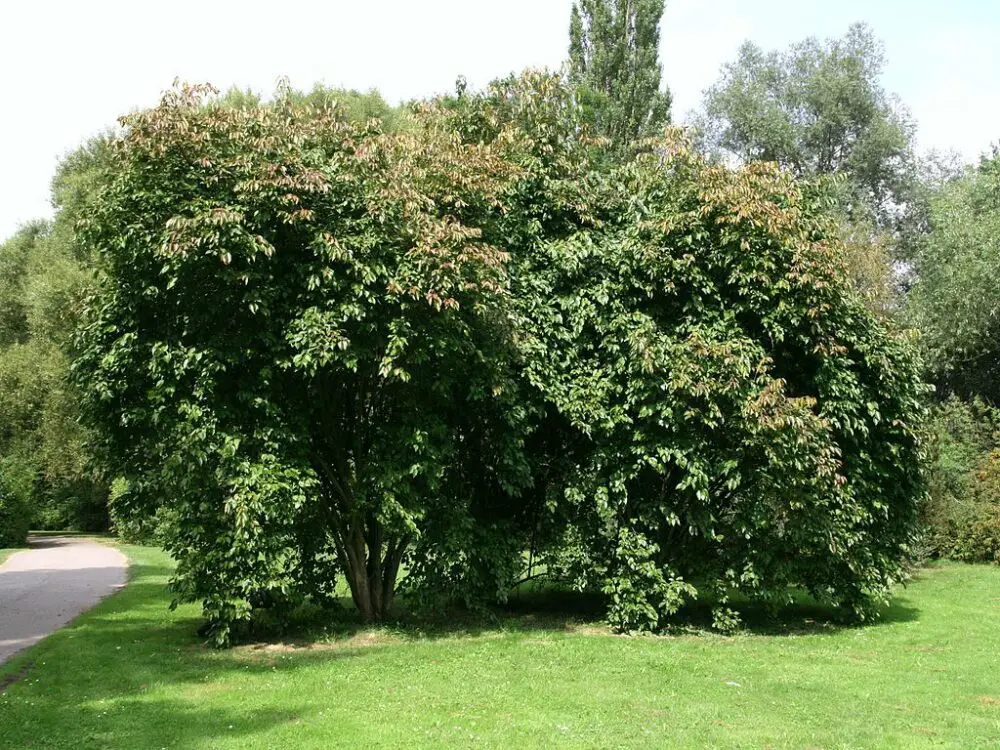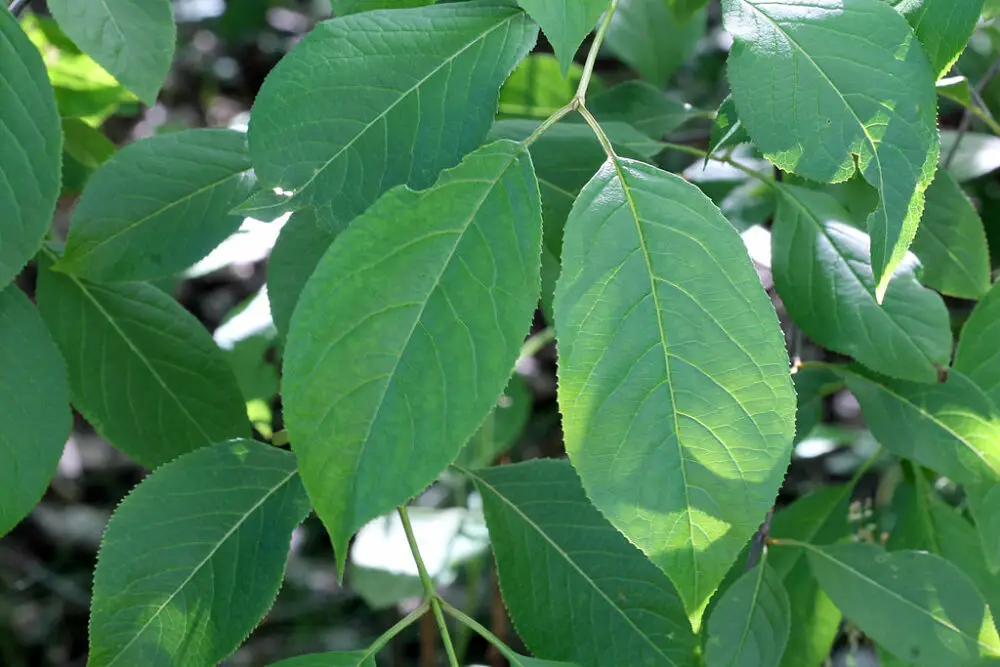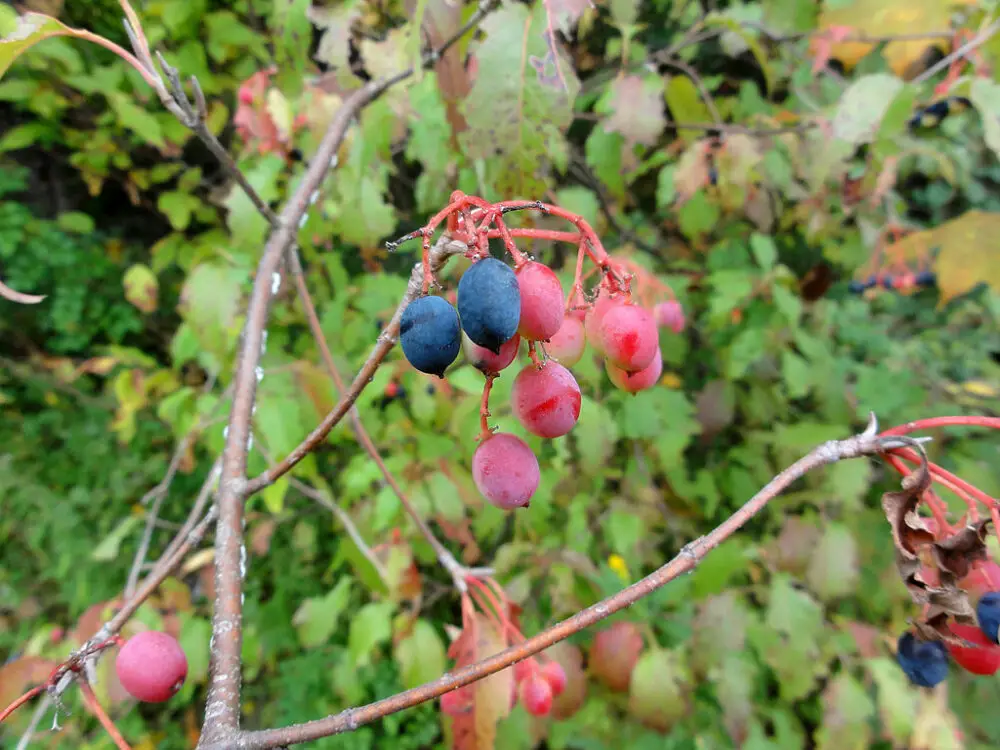Native to North America, nannyberries (Viburnum lentago) are suckering shrubs that can be grown on a variety of soil types. Nannyberry has creamy white flowers in spring and edible fruits in the fall.
Viburnum lentago plant profile
| Scientific name | Viburnum lentago |
| Family name | Adoxaceae, Moschatel family |
| Plant type | Deciduous shrub or single- or small multi-stemmed tree |
| Kingdom | Plantae |
| Genus | Viburnum |
| Phylum | Vascular plant |
| Habitat | Rocky woodlands, mesic woodlands, low woodlands, stream banks, thickets, roadsides, and fence rows |
| Flower color | White |
| Bloom time | Showy white flowers in late spring to May, burgundy autumn leaf fall color, and dark blue berries |
Common names include:
- Nannyberry
- Wild raisin
- Sweet viburnum
- Sheepberry
- Blackhaw
- Cowberry
- Nannyberry viburnum
- Nanny plum
- Sweetberry
- Tea plant
Why is it called Nannyberry?
Nanny goats generally feed on ripe berries (reportedly more so than billy goats), hence their common name.
When overripe, the fruit of this plant smells like wet sheep wool, which is why it is also called sheepberry.
What Are You Foraging For Right Now?
We're thrilled to hear your ideas. What would you like to submit today? Feel free to share your thoughts and experiences with us.
Where does nannyberry grow?
Nannyberries are widespread in eastern North America. They can grow in full sun or part shade in the midwest.
It is recommended that nannyberry shrubs be grown in USDA plant hardiness zones 2 through 8, so those living in hot climates cannot grow them.

How to identify nannyberry
A close look at the petioles on nannyberry can clear up any doubt about its identity: the wings are wavy and irregular, unlike those on other shrubs.
At the tips of one-year-old branches, there are dense, rounded flower clusters measuring between 2 and 3 and 1/2 inches in diameter.
Inflorescences are creamy white, about 1/4 inches in diameter, bell-shaped to saucer-shaped, with five rounded lobes.
A single, short style is located in the center, along with five long, yellow-tipped stamens extending far beyond the floral tube’s mouth.
There are five small, triangular lobes on the calyx around the base of the flower. The flower stalks are hairless and green to red in color.
Its leaves are simple and opposite, lance-elliptic to nearly oval, 2 to 4 inches long, 1 and 1/4 to 2 and 1/4 inches wide, with an abrupt taper to a sharply pointed tip, and rounded at the base. Leaf stalks range in length from 1/2 to 1 1/4 inches and are usually flattened with irregular wings.

There is no hair on the surface; the upper surface is dark green and shiny, whereas the lower surface is paler and mostly smooth or covered with tiny scales. The edges are crowded with short, sharp teeth.
In addition to grayish brown twigs that are slender and straight, the buds of this plant are pinkish-brown and slender, measuring up to 1/2 inches in length, and the flower buds appear swollen at the base.
Typically, the fruit consists of a slightly flattened, elliptical, fleshy, berry-like drupe, 1/3 to 1 and 1/2 inches in length, green, changing to purple-red, and then darkening to blue-black, containing one seed.

Can you eat Nannyberry berries?
Yes, the berries of this native tree are delicious.
You can eat the fruits when they are ripe off the bush or use them in purees or fruit leathers.
Nannyberry Uses in the kitchen
- You can eat the fruit of this native plant raw or cooked.
- You can make tea, jam, jelly, and dried fruit with berries.
- You can crush it up and put it in a smoothie or milkshake.
- Desserts like pies, cakes, and sorbets can be done with nannyberry extract.
- They’re also good as appetizers and on cheese boards.
- You can dry these berries and eat them later as a snack.
A few recipes I really like:
Nannyberry: medicinal uses and benefits
- Native Americans also used bark and leaves in herbal medicine.
- Measles can be treated with an infusion of the leaves.
- The leaves have also been used in infusions or poultices applied for dysuria (painful urination).
- Root decoction is used to treat irregular menstruation and blood spitting.
- A tea made from the tree’s bark has antispasmodic properties, so it’s great for cramps and muscle spasms.
- The juice from the nannyberry is good for digestion, menstrual problems, pain relief, anxiety relief, and more.
Ana has always been interested in all things nature and flora. With her expertise in home gardening and interest in foraging, she has been spending her weekends and free time looking for edible native plants, flowers, and fungi. One of her many hobbies includes testing new savory and sweet recipes, juices or teas made from freshly picked plants, wild fruits, or mushrooms.

